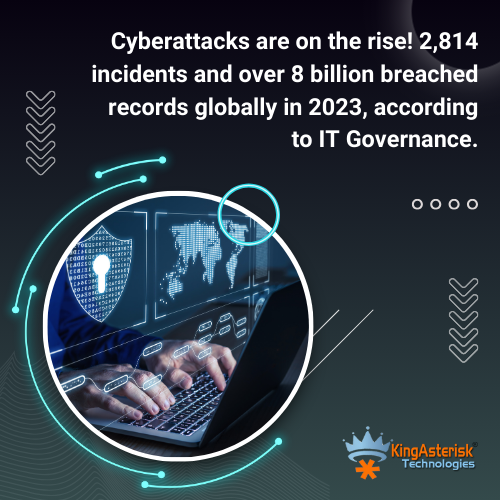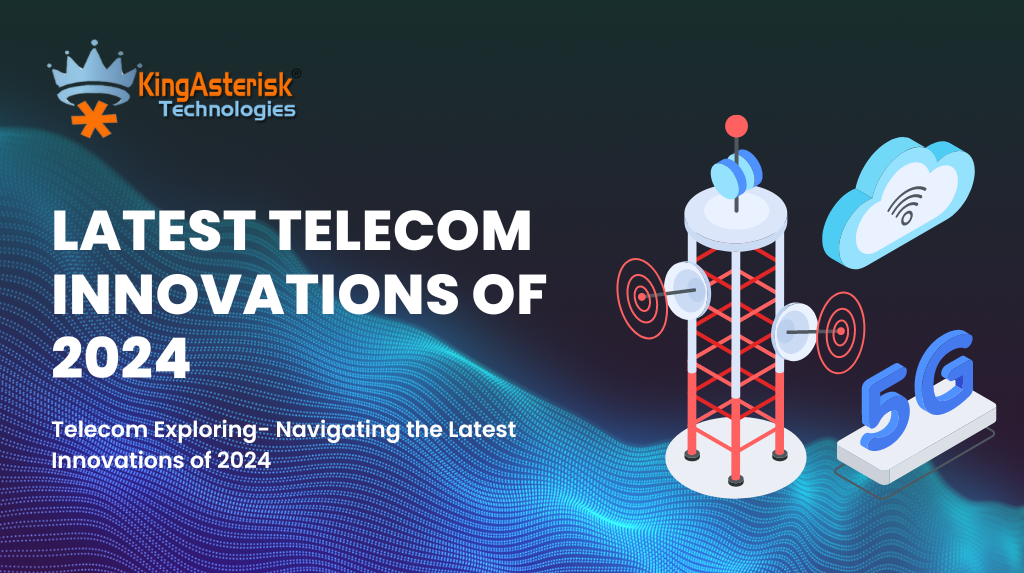The Global Telecommunication Market is projected to reach a value of USD 2652.5 Billion by 2030 at a CAGR (Compound Annual Growth Rate) of 5.3% between 2023 and 2030.
Can you see how huge the data is? That is the reason we, at KingAsterisk, are excited to present our Dialer Solutions in 2024. These are an ideal mix of usefulness and aesthetics that is leaving our clients charmed and fulfilled.
Drained clients were also enthusiastically looking for a much needed refresher in their telecom Solutions. Enter Dialer 2024, swooping in to save the day with its sleek design and unparalleled performance. Gone are the days of settling for mediocrity now. Our clients now revel in the seamless experience provided by our unique technology.
Technology-driven Digital Transformations: AI and Automation
Artificial intelligence is set to emerge as a cornerstone. It will seamlessly integrate into core operations to elevate network performance, customize customer interactions, and instigate self-healing capabilities within the infrastructure. And we all will witness this happening in 2024. A shift with chatbots evolving into highly sophisticated entities, network management gaining autonomy, and fraud detection undergoing a revolutionary makeover.
Imagine a market where issues are preemptively identified before they surface. Tickets are generated automatically using intricate network and user behavioral data, and customer experience takes center stage in the industry narrative. 2024 promises a telecom revolution with telecom digital transformation. Innovation converges with AI, steering the industry toward unparalleled efficiency and unparalleled customer engagement. And honestly, we all tech savyy people are waiting for this.
Cloud Computing – Powering the Digital Age
According to MarketsandMarkets, “The Global Telecom Cloud Market is estimated to reach $32.5 billion by 2027, growing at a CAGR of 23.1%”.
Today, telecom companies can easily ditch bulky hardware setups and on-premise servers. The Cloud enables them to manage their entire network through a virtual dashboard. And KingAsterisk Technology is providing an effective call center dialer solution which can be customized as per needs and wants. Operators can quickly adapt to the cloud contact centers changing market conditions and even experiment with new services or business models to stay competitive in the market. As per Juniper Research, “Telecom IT spending on cloud is expected to reach 26% by 2024, up from 18% in 2022.”
Unified Communications (UC) Integration
Unified Communications (UC) emerges as a guiding light in the telecom industry. It is used mostly for the seamless integration of VoIP with messaging and collaboration tools. This intermingling makes a unified platform, eradicating communication storehouses inside associations.
The outcome is increased team efficiency and an exchange of information and thoughts. With the support of wholesale voice termination, this integration becomes not just a technological upgrade but a strategic move in creating a unified, efficient, and interconnected communication ecosystem.
The integration of Unified Communications isn’t just a technological upgrade; it’s a cultural evolution in how businesses approach collaboration.
Simplified Networks For Better Customer Experience (CX)
As the adoption of SD-WAN and SASE continues to fuel global expansion for enterprises, automation, AI and cost optimization will drive network simplification for better CX. Demand for end-to-end security for remote and Modern Contact Centers access encourages providers to support SASE, SD-WAN, wireless WAN and platform-based managed network services with enhanced broadband offerings in a hybrid cloud environment. With developments in virtual/cloud network functions, this year will bring about the perfect fusion of security, network as a service (NaaS), decentralized edge networking and AI.
Rise of WebRTC
WebRTC, or Web Real-Time Communication, enables real-time communication directly within web browsers without additional plugins. WebRTC enables users to initiate voice and video communication directly from their web browsers, streamlining the user experience by removing the need for additional downloads or installations. It embedded communication abilities straightforwardly into sites and applications. Throat this it enhances customer engagement, which is particularly useful in customer service and e-commerce environments.
Evolving the Superior Customer Experience: Super Apps
The future looks towards the era of “super apps,” where social media, self-care, banking, e-commerce, and messaging seamlessly converge under the auspices of telecommunication providers. Picture a digital ecosystem where telcos orchestrate an integrated suite of services, offering a one-stop-shop for users’ multifaceted needs.
Decentralizing the Network Through Edge Computing
Edge computing, the practice of processing data closer to the source rather than relying on centralized cloud servers, is another telecom trend that will gain momentum in 2024.
Every telecom company’s network has “blind spots” or areas where they don’t have the strongest coverage. To remain important and to keep on extending their organization, they’ll have to work with accomplices to fill those gaps. The companies that build strong dialer software partnerships will come out on top in 2024.
Low-code/no-code Revolution
Revolutionizing the operational dynamics of companies, agile development platforms equipped with low-code or no-code programming capabilities are poised to redefine efficiency and innovation in the industry. The ability to make real-time adjustments to customer journeys and implement on-demand updates to mobile applications and web portals, all without requiring intricate code changes, stands as pivotal.
Internet of Things (IoT) – A Connected Future
There was a time when IoT was a huge buzz, however today, it has become an amazing reality. We are surrounded by everything ‘smart’ – from smart homes and wearables to connected cars and even industrial sensors. Moreover, it is not only about the amount of data traffic but also the diversity of the data that networks need to support.
Telecom Operators are investing in network infrastructure by deploying LPWANs i.e. Low-Power Wide-Area Networks to cater to the diverse requirements of IoT applications.
Network Slicing for Diverse Telecommunication Services
Network slicing is a technology in call center solution that allows telecom companies like Telstra to carve up our network into separate, secure “slices,” that can be finely tuned to suit the needs of many customers and customer applications. Some of the key reasons are the rigidness of the traditional networks, the rising complexities of the networks, the need for rapid services, etc. These slices can be tailored to provide even more secure and reliable network experience, and in 2024, we can expect network slicing to become more prevalent.
5G Takes the Center Stage: Mainstream Adoption
A surge in widespread adoption is on the horizon, unfurling the gateway for the integration of next-generation applications such as autonomous vehicles, immersive VR/AR experiences, and the realization of smart cities. The time taken while sending and receiving data over the internet i.e. Latency is also near-instantaneous. Users can experience real-time responsiveness with latency as low as 1 millisecond.
Compared to 4G, it can connect 100 times more devices per unit area. So, in a crowded area like a stadium where everyone’s streaming, gaming, calling, and whatnot, 5G ensures smooth connectivity. The 5G chips away at higher recurrence teams and high level radio wire innovations. For the telecom organizations it’s positively a boon.
Personalized Security :
In the past, cyber threats were typically one dimensional. However, “blended” cyber threats are becoming increasingly commonplace and often target multiple touch points across the business.
Cyberattacks are on the rise! 2,814 incidents and over 8 billion breached records globally in 2023, according to IT Governance.

Continuing to Support Hybrid Work and Remote Connectivity
The global shift towards hybrid work models and remote connectivity, accelerated by the COVID-19 pandemic, will continue to influence telecom trends in 2024. The interest for dependable, rapid speed and consistent availability will continue as remote work and digital coordinated effort become vital to current workplaces.
But what sets Dialer 2024 apart?
It’s not just about looks – although its sleek interface certainly catches the eye. From upgraded call management elements to UIs, Dialer 2024 transforms communicating successfully in the advanced age.
If we explore the growth curve of the telecom industry, technologies like 5G and beyond and the Internet of Things (IoT) are expected to increase the number of subscriptions to 2.8 billion by the close of 2023 (as per the Ericsson Mobility Report). Telecommunication Additionally, the rise of massive IoT devices and connections is set to beat 20 billion by the end of 2023.
Conclusion :-
It’s clear that Dialer 2024 is leading the way. As we look ahead to the next 12-18 months, clear pressures will define the telecoms industry. This will be driven by top cloud communication trends by big businesses and consumer requests. As a “Technology First” company and a pioneer in offering smart product engineering. A portion of our skill are quality designing, UI/UX, DevOps, and more administrations to capacity, computing, organizing spaces,etc. But don’t just take our word for it – our clients speak for themselves.
Overwhelmingly, they express their satisfaction and delight with the new functionality and look of Dialer 2024. Kingasterisk Technology can assist telecom with adjusting suppliers in making dependable and elite execution with latest arrangements. Read our other blogs and if you still have any doubts please reach out to us. We are eager to hear from you!




